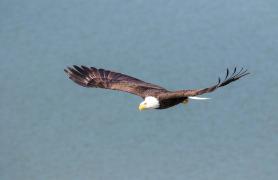If you’re a duck hunter, birder, or wildlife enthusiast, you’re familiar with wetlands’ beauty and astonishing natural diversity. In addition, wetlands are a kind of habitat that most Missourians and Missouri wildlife can’t do without.
As sponges, filters, and buffers, wetlands absorb floodwaters, protecting farmland and cities from inundation, and they filter pollutants and nutrients from storm water. Water quality is one of the most important reasons to care about wetlands. They also help support many birds, bats, and insects that play important roles in pollinating and providing pest control for native plants and crops.
Like coastal estuaries, inland wetlands are wildlife nurseries. Hundreds of species of wildlife depend on these areas to nest and spawn every year. In our state, wetlands host at least 110 of the more than 430 bird species recorded in Missouri for part of their life cycle. Over 200 Missouri species of conservation concern use wetlands as their primary habitat. The staggering amount of vegetation and other food sources wetlands produce help support plants and animals living in streams and on adjoining floodplains and uplands.
Wetland Redux
Since settlement times, Missouri’s vital wetlands have been mostly eliminated or altered. Over 87 percent of the state’s original 4.8 million acres of wetland habitat were lost to farming, road building, and urban development. But restoration efforts like Barb and Wayne Cunninghams’ [see Habitat Heroes] are good news for Missouri’s wetlands. The Missouri Department of Conservation, other state and federal agencies, conservation organizations, agricultural producers, and private landowners are working together to restore and manage thousands of acres of wetlands on private and public land.
As a result, wetland-dependent species have responded positively. Today, wetland complexes along the Mississippi and Missouri rivers and their tributaries are recognized for their continental significance to waterfowl, water birds, and land birds. In addition, efforts to restore connectivity to floodplains have helped struggling river fishes like sturgeon and paddlefish. Newly restored wetlands are helping declining frog and salamander populations increase their numbers.
Habitat Heroes
In Chariton County, Barb and Wayne Cunningham and their brothers have been working with Department Wetland Services Biologist Mike McClure and other Natural Resources Conservation Services (NRCS) Wetland Emphasis Team members to restore wetlands on more than 650 acres of their land. It’s not far from Swan Lake National Wildlife Refuge, and it lies along Yellow Creek in the lower Grand River basin.
“We’re kind of wildlife refuge manager wannabes,” Barb Cunningham says. “Swan Lake was a big deal to us. We were very much inspired by seeing what Swan Lake managers did.
“In 1990, we had an opportunity to get our first marsh. Th en the Wetland Reserve Program came, and that’s when we signed most of it into the easement program. We stretched ourselves to expand when opportunities arose, and we’ve turned it into something we’re pretty proud of.”
Missouri has Five General Kinds of Wetlands
Wetlands are natural communities that result when permanent or periodic saturation robs the soil of oxygen so that only water-tolerant plants can live there. Plants and animals living in oxygen-poor wetland communities have specific adaptations to help them deal with ever-changing water levels. Scientists group wetland types according to differences in soils, water presence and duration, and wetland plants. Specific wetland animals then take advantage of these different habitat characteristics.
Seasonal These wetlands typically hold water in the fall through spring and dry up in summer. Some occur in river floodplains, where they produce plants such as smartweeds and wild millet that provide important food sources for migrating waterfowl. Fishless wetlands can also form in upland depressions, serving as important larval nurseries for frogs, toads, and salamanders.
Emergent Marsh These semi-permanently flooded wetlands feature soft -stemmed plants like reeds, sedges, and smartweeds. They provide important habitat for amphibians, reptiles, dragonflies, muskrats, wading birds, and other wildlife.
Shrub-Scrub Basin-like depressions with poorly to very poorly drained soils receive periodic flooding. Shrubs and small trees like buttonbush, black willow, and swamp privet dominate. A variety of amphibians, reptiles, migrating songbirds, and other wildlife depend on them for roosting cover, foraging, and breeding habitat.
Forested Swamp Trees and shrubs such as bald cypress, water tupelo, and overcup oak that are adapted to alternating periods of flood and drought typify this kind of swamp. Green treefrogs, western mud snakes, wood ducks, hooded mergansers, warblers, barred owls, and other wildlife depend on forested swamps for habitat.
Fen These unique wetlands found in the Ozark Highlands and Central Till Plains ecoregions are created by constantly seeping mineralized groundwater. Typically small-patch communities, they are nonetheless quite diverse. Plants include swamp wood betony and a number of sedge and rush species. Fens are primary habitat for the gray petaltail dragonfly and the federally endangered Hine’s emerald dragonfly.
A host of water birds and numerous fishes use shrub-scrub wetlands. A wide range of wetland vegetation including perennial smartweeds, rice cutgrass, beggar ticks, and sedges can be found, along with scattered groupings of willows and buttonbush.
Emergent marshes like those found at B.K. Leach CA have different vegetation zones based on patterns of water depth and soil types. Bitterns and rails use the area during migration and for breeding habitat.
Reconstructed seasonal wetland systems like those at Prairie Fork CA provide habitat for migrating soras, yellow rails, mallards, digger crayfish, and small-mouthed salamanders.
Historically, 2.3 million acres of forest covered the Mississippi lowlands of southeast Missouri. Only a fraction of that remains today. The Mingo Basin represents over half of this remaining bottomland habitat that provides for a host of wildlife, including both nesting and migrant waterfowl and forest birds.
Grasshopper Hollow Natural Area contains the largest known fen complex in unglaciated North America, and management work here directly benefits many plants and animals of conservation concern.
Wetlands
WRE Makes it Permanent
Wetland conservation opportunity areas are places that offer some of the greatest potential for landowners and other conservation partners to do the most good for Missouri’s wetland habitats and the fish and wildlife that depend on them. Whether your land lies along a big river or hosts a small fen, you can get help and funding to manage your
Wetlands
WRE Makes it Permanent
Operated by the United States Department of Agriculture/NRCS, the Wetlands Reserve Easement program (WRE) helps cropland owners turn flood-prone acres back into wetlands. Landowners who enter into WRE agree to a perpetual easement that protects their land’s wetland values, regardless of who owns the land in the future.
In addition to a one-time payment equal to fair-market value of cropland or timber (depending on the kind of acres enrolled), participating landowners get help with wetland restoration costs, which are covered by NRCS.
McClure explains why WRE is such a good deal. “Farming floodprone land is expensive. When we help farmers turn those acres back into wetlands, everybody comes out money ahead, and wildlife benefit, too.”
The Cunninghams appreciate the help. “In the beginning,” Barb Cunningham says, “we were high on enthusiasm but short on knowledge. Now we feel like we’re doing the best we can to be the best caretakers. It’s only yours as long as you’re here.”
Do You Have a Wetland?
If you have acres that were formerly wetland or are currently degraded wetland, you may be eligible for help restoring them. Here are some general clues to tell if your land is a wetland or has wetland potential.
Is the area wet?
Land has to be wet at least some of the time in order to be classified as a wetland.
Does your soil hold water or have the capability to do so?
Wetlands require a certain percentage of the soil be hydric. This means it has the ability to hold water, as do soils having high clay content.
Do the plants love water?
Tree species like green ash and willows are great indicators, while annual and perennial plants like smartweeds, millets, and sedges are also signals that you may have a wetland on your property.
Do you see wetland wildlife?
The presence of reptiles, amphibians, and waterfowl are an excellent way to help you determine whether or not you are dealing with a true wetland.
If you are able to identify some of the factors listed above, it may be worth calling your county’s field practitioner to take the next step.
Visit Public Wetlands
Discover and explore all of Missouri’s beautiful public wetlands. Just visit mdc.mo.gov/atlas and browse by natural feature. Waterfowl and Wetland Conservation in Missouri.
Discover the unique history of the Missouri model of wetland and waterfowl management in this large format and richly illustrated book. Available for $40 at short.mdc.mo.gov/Z46. All proceeds support wetland and waterfowl conservation in Missouri.




















Also In This Issue


And More...
This Issue's Staff
Art Director - Cliff White
Associate Editor - Bonnie Chasteen
Staff Writer - Heather Feeler
Staff Writer - Kristie Hilgedick
Staff Writer - Joe Jerek
Photographer - Noppadol Paothong
Photographer - David Stonner
Designer - Les Fortenberry
Designer - Marci Porter
Designer - Stephanie Thurber
Circulation - Laura Scheuler






















